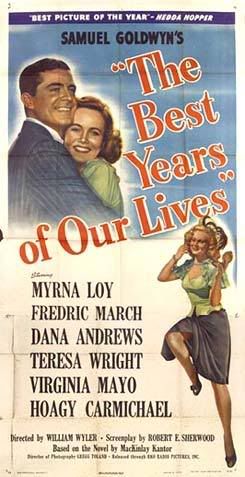==from Filmsite.org==The Best Years of Our Lives (1946) is producer Samuel Goldwyn's classic, significant American film about the difficult, traumatic adjustments (unemployment, adultery, alcoholism, and ostracism) that three returning veteran servicemen experienced in the aftermath of World War II. In more modern times, Coming Home (1978) portrayed the same plight of the returning serviceman. The major stars, who each gave the performance of their lives in this Best Picture winner, were:
* Fredric March as the eldest returning veteran, alcoholic Army Sergeant Al Stephenson, married to loyal Milly (Myrna Loy)
* Dana Andrews as handsome Air Force bombadier Fred Derry, involved in two romances - with party-girl wife Marie (Virginia Mayo), and in a new love relationship with Al's daughter Peggy (Teresa Wright)
* Harold Russell (almost uncredited in the film) as sailor Homer Parrish (a WWII vet), the hometown's former football hero, with fiancee/girlfriend Wilma (Cathy O'Donnell)
The germinal idea for the literate, meticulously-constructed film came from a Time Magazine pictorial article (August 7, 1944) that was then re-fashioned into a novel titled Glory for Me by commissioned author MacKinlay Kantor. Kantor's blank-verse novel was the basis for an adapted screenplay by distinguished Pulitzer Prize winning scriptwriter Robert E. Sherwood (his earlier works were The Petrified Forest and Idiot's Delight).
The ironic title refers to the troubling fact that many servicemen had 'the best years of their lives' in wartime, not in their experiences afterwards in peacetime America when they were forced to adapt to the much-changed demands and became the victims of dislocating forces. However, it could be argued that the servicemen also gave up and sacrificed 'the best years of their lives' - their youthful innocence and health - by serving in the military and becoming disjointed from normal civilian life. [Photographs in the houses of each of the returning servicemen recall an earlier time that was irretrievably past.]
The poignant, moving film realistically transports its present-day audiences back to the setting of the late 1940s, where the film's three typical protagonists return from their honored wartime roles to their past, altered middle-American lives and are immediately thrust into domestic tragedies, uncertainties, conflicts and awkward situations - handicapped (both physically and emotionally) by their new civilian roles. Wyler's Best Picture-winning Mrs. Miniver (1942) can be considered as a companion piece to this film, from the British perspective.
The superb, eloquent, and realistically-intimate film was nominated for eight Academy Awards and won seven Oscars: Best Picture (Samuel Goldwyn's sole competitive Oscar win), Best Actor (Fredric March - his second Oscar - the first was for Dr. Jekyll and Mr. Hyde (1932)), Best Supporting Actor (Harold Russell), Best Director (William Wyler - his second of three career Oscars), Best Screenplay (Robert E. Sherwood), Best Editing, Best Musical Score -- its nomination for Best Sound was the only one that failed to win. Real-life double amputee (from a ship explosion) and one of the cast's inexperienced actors - Harold Russell received an additional Special Honorary Oscar "for bringing hope and courage to fellow veterans" for his first performance. [Russell is the only actor ever to win two Oscars for the same role. He wouldn't act again until Inside Moves (1980) and Dogtown (1997).] Under-rated actor Dana Andrews was denied a deserved Oscar nomination, as a returning 'fly-boy.'
Oscar-winning epic director William Wyler's cinematographer, Gregg Toland, known for his depth of focus camerawork in previous films (such as Citizen Kane (1941) and The Little Foxes (1941)) contributed his talent to the three-hour long black and white film masterpiece with richly-textured and crisp images, deep-focus shots, and framed scenes. Wyler had experienced wartime himself in the US Army Air Corps, during which he made three morale-boosting, war-related documentaries: The Fighting Lady (1944), The Memphis Belle (1944), and Thunderbolt (1945). The film was producer Samuel Goldwyn's most successful and important work - he also was presented with the Irving Thalberg Memorial Award. The film was a major commercial success - the biggest box-office draw since Gone With The Wind (1939).
 ==Leslie notes==
==Leslie notes==I saw this movie on TV on Thanksgiving weekend, circa 1980. I had never heard of it and was completely unprepared for it. It remains one of my favorite movies but I can only watch it every now and then...it is just too hard to take (for me).
Next up: Z in 1934




